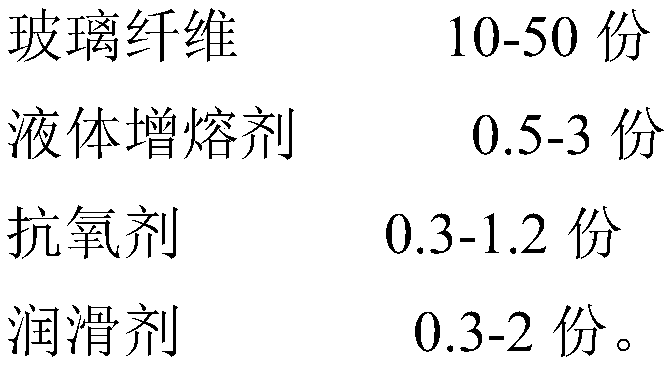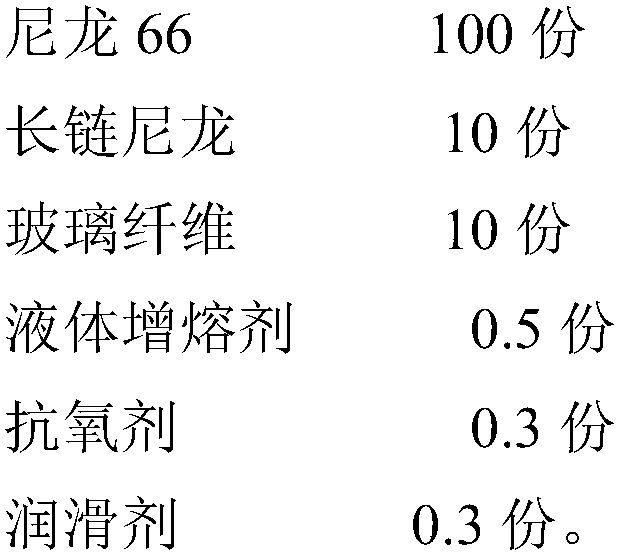A polyamide material with stable melt and chloride solution resistance and preparation method thereof
A chloride and polyamide technology, which is applied in the field of polyamide materials and its preparation, can solve the problems of unstable melt, adverse effects of stable mechanical properties of materials, poor resistance to calcium chloride, etc., and achieve excellent resistance to chloride salts Corrosion, improve the strength of the resin solution, and stabilize the production and processing process
- Summary
- Abstract
- Description
- Claims
- Application Information
AI Technical Summary
Problems solved by technology
Method used
Image
Examples
Embodiment 1
[0038] (1) Dry nylon at 110°C for 2 hours.
[0039] (2) Weigh 100 parts of PA66 (relative molecular weight 15000-20000), 10 parts of PA610 (relative molecular weight 6000-10000), and premix 0.5 parts of epoxy-terminated polybutadiene evenly, then add 0.3 parts of antioxidant and lubricating Add 0.3 parts of the agent into the premix and mix into a homogeneous mixture;
[0040] (3) Add the mixture from the first barrel of the twin-screw extruder, add 10 parts of glass fiber through the glass fiber port, control the speed at 1100r / min, and the temperature at 260-270°C for extrusion and granulation. After being extruded, it is pelletized with supercooled water.
[0041] (4) Dry the cut particles and inject them into molds at 260-275°C. test.
Embodiment 2
[0043] (1) Dry the nylon at 110°C for 2 hours.
[0044] (2) Weigh 100 parts of PA66 (relative molecular weight 15000-30000), 45 parts of PA610 (relative molecular weight 6000-18000), premix 3 parts of epoxy-terminated polybutadiene, and then add 1.2 parts of antioxidant and lubricating Mix 2 parts of the agent into the premix and mix into a homogeneous mixture;
[0045] (3) Add the mixture from the first barrel of the twin-screw extruder, add 50 parts of glass fiber from the second glass fiber port, control the rotation speed at 1100r / min, and the temperature at 260-270°C to carry out extrusion granulation, After the material is extruded, it is pelletized by subcooling water.
[0046] (4) Dry the cut particles and inject them into molds at 260-275°C. test.
Embodiment 3
[0048] (1) Dry nylon at 110°C for 2 hours.
[0049] (2) Weigh 100 parts of PA66 (relative molecular weight 15000-30000), 20 parts of PA610 (relative molecular weight 6000-10000), and premix 1.5 parts of epoxy-terminated polybutadiene, and then mix 0.7 parts of antioxidant and lubricating Add 1.4 parts of the agent into the premix and mix into a homogeneous mixture;
[0050] (3) Add the mixture from the first barrel of the twin-screw extruder, add 30 parts of glass fiber from the fourth barrel, control the speed at 1100r / min, and the temperature at 260-270°C for extrusion granulation , After the material is extruded, it is pelletized by subcooling water.
[0051] (4) Dry the cut particles and inject them into molds at 260-275°C. test.
PUM
| Property | Measurement | Unit |
|---|---|---|
| epoxy value | aaaaa | aaaaa |
| diameter | aaaaa | aaaaa |
Abstract
Description
Claims
Application Information
 Login to View More
Login to View More - R&D
- Intellectual Property
- Life Sciences
- Materials
- Tech Scout
- Unparalleled Data Quality
- Higher Quality Content
- 60% Fewer Hallucinations
Browse by: Latest US Patents, China's latest patents, Technical Efficacy Thesaurus, Application Domain, Technology Topic, Popular Technical Reports.
© 2025 PatSnap. All rights reserved.Legal|Privacy policy|Modern Slavery Act Transparency Statement|Sitemap|About US| Contact US: help@patsnap.com



